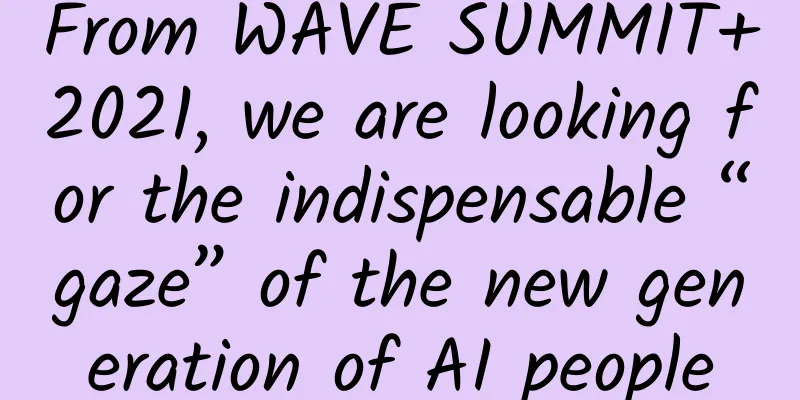From WAVE SUMMIT+2021, we are looking for the indispensable “gaze” of the new generation of AI people

|
When we talk about AI, we always associate it with terms like cutting-edge, cool, and laboratory. But for some groups, AI is a distant term, while the challenges they face every day are real. Salt miners in a salt field in Shandong need to breathe corrosive air and work under the scorching sun. Visually impaired people who want to get a guide dog have to wait in line for a long time, and the cost of training a guide dog is also very high; After the double reduction, working mothers need to spend more time worrying about their children's education and growth, which makes them physically and mentally exhausted... Should these people’s work and lives be changed by AI? The answer is yes. Science and technology have become the most powerful driving force of modern human society. The Handbook of Technological Ethics, edited by Dr. Armin Grunwald of Germany, states that people should consciously use the imagination of technology for the purpose of developing technological innovation, regardless of gender, age, education level and cultural background, to bring benefits to as many people and social groups as possible. At the same time, the answer is also uncertain, because in order to allow more people to share the benefits of technology, it requires the participation of a large number of developers and geeks who are willing to focus on these fields and promote the integration of technology with industries, scenarios, and needs. This is not something that will happen naturally. Continuously expanding the scope of action and imagination space for the development and application of AI technology is an indispensable and crucial "gaze" for all mankind in the intelligent era. On December 12, the WAVE SUMMIT+2021 Deep Learning Developer Summit, hosted by the National Engineering Laboratory for Deep Learning Technology and Applications, was held in Shanghai. At this technical event that brought together many AI developers, I truly felt that the new generation of AI talents are focusing on more and more groups and scenarios. Among them, Baidu PaddlePaddle deep learning platform has become a link between them. Through these various perspectives, the connection between people and AI, and between people, is becoming closer than ever before. I interviewed many young AI developers on the spot and hope to tell you their stories. From their perspectives, you may be able to discover the eyes, heart, and path of intelligent China. Eyes: Looking for the “gaze” of the times at WAVE SUMMIT+2021 Gaze is a concept proposed by philosopher Lacan, who believes that people can understand themselves by seeing others, and then establish connections between themselves and others. In the process of AI development, it is essential to allow more groups to be seen and more developers to have the desire and possibility to "gaze" at others. For example, the proportion of female technology practitioners is relatively small, and it is difficult for some non-technical people to actively apply technology. Their underrepresentation in the technology industry makes it easy for algorithmic bias or errors to occur. If AI is to benefit the whole society as much as possible, it needs more diverse and innovative talents who "focus" on various groups. At this WAVE SUMMIT+ Deep Learning Developer Summit, I saw a different technological landscape through many young AI developers. Gao Hongzhi, a technical expert and developer of PaddlePaddle, saw the scarcity of guide dogs and the real problems faced by the blind in traveling. He combined low-cost robot dog hardware and Baidu PaddlePaddle's open source capabilities in the field of computer vision to develop a robot guide dog that may help the blind in transportation and daily life in the future. Computer science students Wang Rongsheng and Yang Guoqing saw the shortage of medical resources in Wuhan during the COVID-19 epidemic prevention and control period while at school, and began to explore the combination of AI and medical care. Through PaddlePaddle, deep learning was used to create an edge heart sound auscultation and diagnosis device that can extract heart sound features and preliminarily identify and diagnose. It can warn of abnormal signals at home, roughly predict four types of heart diseases, urge suspected patients to seek medical treatment in time, and reduce the misdiagnosis rate of heart diseases in practice. Feng Huiyu, a junior student at Qingdao Agricultural University, saw a field that is rarely paid attention to but is closely related to people's lives: salt drying. In Changyi, Shandong, the hometown of the team members, people have always used traditional methods to dry salt, which requires manual measurement of water levels and manual plowing to prevent hardening. The sea breeze in the working environment is highly humid and corrosive, and irritating to the skin; the sun is too strong and the ultraviolet rays are strong, so people who work in salt drying for a long time are easily injured by the sea breeze. "Aren't there water level sensors already available? Why don't they be used in salt fields?" Feng Huiyu smiled and said that he had thought about it before, but later discovered that the concentration of salt water is very high. Currently, common liquid sensors can only measure ion concentrations, and salt ponds are often saturated solutions, so sensors cannot be used. In the end, he and his team chose the image recognition method, collected pictures of salt fields at different stages, selected and trained models through PaddlePaddle, and developed the "Intelligent Recognition and Auxiliary Diagnosis of Circle Salt Drying Images" application project, which can observe indicators such as the water volume and crystallinity of salt fields in real time, and promptly remind staff to collect salt, greatly reducing the burden on salt field workers. Kou Yao, who graduated with a master's degree in arts and cultural management, often hears her friends who have become mothers complain: children are always bored staying in the car, and the pressure of driving and taking care of the children is too great... She wondered whether she could combine AI with smart cars to build a mobile cabin for children and use the travel time for immersive interactive education? So she used Baidu PaddlePaddle and image recognition technology to allow car windows to interact with children, explaining things in street scenes to satisfy children's curiosity; through image segmentation and rendering, she developed a function for painting on car windows, which can stimulate children's innovative thinking anytime and anywhere during travel. When encountering tunnels or night scenes, the car automatically renders a metaverse-like starry sky effect, turning the sudden darkness into a beautiful memory. Speaking of the metaverse, Wang Mengyao, who is studying science and technology art at the Central Academy of Fine Arts, combined traditional Chinese painting elements with AI to create a "traditional Chinese painting version" of the metaverse. She used the image segmentation technology of PaddlePaddle to segment out elements such as people, mountains, waters, trees, flowers and birds in traditional Chinese paintings, and reshaped the world in a new 3D space in virtual space, guiding the audience to explore the mountains and waters in classic traditional Chinese paintings of all dynasties in this metaverse world through VR equipment, allowing the audience to see the beauty of traditional Chinese culture in the color and ink. There are many similar cases in the developer market at WAVE SUMMIT+2021. AI developers of all professions, genders, and ages have shown me what kind of vibrant technological innovation will be brought about when this generation of talents gazes into the endless distance and countless people. Heart: Listen to the voices of innovative talents and see how the AI dream is woven? While marveling at the richness and diversity of the AI ecosystem, I also discovered what practical needs some developers, especially those with no AI foundation or students in school, have when pursuing their AI dreams. 1. Leaders. Many AI developers are not majoring in machine learning or even computer science. This allows AI to cross fields and innovate, but it also makes it difficult for many developers to get started and practice. At this time, AI professionals are needed to play the role of "leaders". Take Feng Huiyu, who is working on the "Smart Salting" project, for example. As an engineering student at an agricultural university, he had nothing to do with AI and his self-study of AI was very slow. Later, after learning about the "AI Talent Creation Camp" launched by the Baidu PaddlePaddle team, he joined the "30-Day AI Project Full Process Practice" and got in touch with the official engineers of PaddlePaddle. During the process, he received detailed guidance and help, and started his own AI research journey. (Huiyu team collects data on site at the salt field) 2. Companions. At WAVE SUMMIT+2021, many outstanding cases of female developers emerged. When communicating with Kou Yao from the "Mobile Cabin" project, she told me that as a female developer, there is a lack of technical atmosphere around her, which has discouraged many women from unleashing their talents in the field of AI. When talking about partners in the PaddlePaddle community, she was particularly excited to mention the help given to her by other project developers and PaddlePaddle technicians. Many of them are talented sisters who are willing to share and help others. These companions on the road of innovation make Kou Yao no longer feel alone. I noticed that in order to activate more women to bravely embrace AI and build a more inclusive and diverse AI community, this WAVE SUMMIT+2021 also set up a special sub-forum on "Scientific and Technological Innovation, Women's Power". Female scientists, teachers, and researchers from the fields of optical communications, Beidou satellite navigation, emotion recognition, low-code development, smart medical care, etc., all shared their insights from their respective research fields, and made the female developers on the scene feel that technology is not far away from women, and women can also give full play to their professional advantages and talents in the intelligent era to support "half the sky" for scientific and technological innovation. What impressed me most was that during the roundtable discussion, several participating guests encouraged the "younger generations" to challenge themselves and tackle "bottleneck" problems. This kind of encouragement from "peers" is very important for many developers to stick to the path of technological innovation. 3. Resource pool. Of course, what AI developers need most and are in short supply are real resources such as toolkits, computing power, and tutorials. Yang Guoqing, a student from the "Heartbeat Signal" project, told me that all the computing work in the research was done on PaddlePaddle, which is very friendly to developers in terms of computing power, enough to support him to complete the project, and has rich APIs and pre-trained models to make his AI development more convenient. In addition, he often visits the PaddlePaddle AI Studio artificial intelligence learning and training community, which has a full range of tutorials for reference. At present, his main expense is the purchase of a relatively expensive development board. Listening to the voices of AI developers on site also made me fully appreciate how powerful the supporting force behind the vigorous development of China's AI and the rise of a new generation of AI people is, and how urgent the need is for developers. Road: Baidu Travel, the future of travel in smart China From the moment the AI boom began, talent shortage has become the main theme of this field. On the one hand, the number of people trained in cutting-edge fields each year is limited, which is difficult to meet the rapidly growing industry employment needs. Major domestic universities have successively opened relevant majors, and technology companies have also implemented industry-education integration strategies in the hope of alleviating the thirst for talent in AI innovation; on the other hand, AI requires compound talents who understand both technology and the industry, which has relatively high requirements and cannot be trained quickly and in a single mode. Therefore, at this year's WAVE SUMMIT, Baidu CTO and Director of the National Engineering Laboratory for Deep Learning Technology and Applications Wang Haifeng specifically mentioned that with the deep integration of AI and industry, the shortage of AI talents will be a long-term challenge, and the future will require more and more compound AI talents who understand AI and have industry experience. PaddlePaddle has always been committed to cultivating compound AI talents, uniting academia and industry to open up a positive cycle of production, learning, research and application, and continuously contributing AI talents to society. The summit also unveiled PaddlePaddle's latest report card: it has attracted 4.06 million developers, created 476,000 models, and served 157,000 enterprises and institutions, ranking first in the comprehensive market share of China's deep learning platform. You may ask, why is Baidu PaddlePaddle at the forefront of the times and a fertile ground for the growth of AI talents? There are three main factors. 1. Baidu's underlying capabilities for technological innovation. Baidu has become a name card for China's AI and is one of the earliest Chinese technology companies to invest in AI's underlying research and development. It can provide a source of technology for cutting-edge exploration by AI developers, universities, and companies. 2. PaddlePaddle’s open source platform features. As China’s first independently developed, feature-rich, open source, industrial-grade deep learning platform, PaddlePaddle continues to open Baidu’s core technologies to the industry and developers. At this summit, PaddlePaddle also released ten latest technologies and ecological developments, including the new version of PaddlePaddle Panorama - the industrial-grade model library added the Wenxin large model, the industry's first industrial practice example library, PaddlePaddle's "Great Voyage" 2.0 co-creation plan, PaddlePaddle open source framework v2.2 systematically added scientific computing API, end-to-end adaptive large-scale distributed training technology, full-process acceleration of text tasks, multi-level low-cost hardware adaptation solutions, industrial-grade open source model library with more than 400 models, enterprise version upgrade automatic and efficient model deployment function, and PaddlePaddle EasyDL desktop version that can complete local efficient modeling in 1 minute. 3. Pay attention to the cultural characteristics of ecology. At the previous WAVE SUMMIT summit, PaddlePaddle officially launched the "Great Voyage" plan, stating that it will invest 1.5 billion yuan in funds and resources in the future to build the PaddlePaddle open source ecosystem through the "Set Sail" plan to work with universities, the "Escort" plan to unite industries, and the "Pilot" plan. At yesterday's WAVE SUMMIT+2021, Wu Tian, vice president of Baidu Group and deputy director of the National Engineering Laboratory for Deep Learning Technology and Applications, released the "Great Voyage" Plan 2.0. Based on the three major channels of embarkation, escort, and navigation, a new "co-creation" plan was added. With the PaddlePaddle platform as the base, community developers co-create tools, models, industry cases and practical experience; form a platform for matching industry innovation needs, and jointly create a positive cycle of production, education, research and application; work with ecological partners to build an artificial intelligence industry empowerment center and jointly create a regional innovation ecosystem. AI is the key to success or failure in the global technological change. Every technical talent is eager to seize this technological gift and become the ferryman and trendsetter of the times. Facing the gap between developers and technology, PaddlePaddle continues to build a prosperous ecological platform and handy tools to ferry the new generation of AI people to the other side of their dreams. Only when AI people are integrated with various industries can rich and diverse creativity be stimulated, helping various industries to improve quality and efficiency, and ultimately achieving self-reliance and breakthroughs in Chinese science and technology. It is not difficult to imagine what a flourishing and innovative scene WAVE will be next year. Talent cultivation is the "road" that Baidu PaddlePaddle adheres to, and it also enables Smart China to accelerate along a solid talent track. There is a passage in the Handbook of Technological Ethics: The progress of science and technology has expanded the possibilities of human action. Things that humans could not do before, or the fate of people who were considered unchangeable, have now become objects that can be changed by technology. The meaning of technology is to seek a future with survival value for most living things, rather than to maximize short-term profits for a few living things. It is said that it takes a hundred years to cultivate a person. For China today, cultivating AI talents is a correct thing to do but it will produce slow results. This is why responsible companies are needed to lay the foundation for long-term value. With PaddlePaddle as the foundation, more outstanding talents have emerged, representing more perspectives on exploring and applying AI. When more groups are illuminated by the light of technology, AI will truly become a technology full of love and kindness, and it also heralds the opening of a larger industrial space. In the rapidly advancing pace of the times, the "gaze" of AI talents is the only way to connect the entire society with the intelligent future. |
Recommend
For 0.002 grams of food, even fish can drive
Written by: Liu Fang Editor: HS Layout: Li Xuewei...
The recall cost was 6 times the company's total assets. This Japanese supplier screwed Ford over badly.
The "death airbags" produced by Japanes...
Can't eat vegetable oil? Is leached oil harmful to the human body? After reading this article, let's eat oil healthily!
gossip Recently, on a short video platform, a use...
Electric Technology Car News: Can the Haval H9 with 8AT gearbox and improved power really compete with Prado?
Speaking of the most controversial mid-size SUV i...
When a promotion operator takes over an App, how should he formulate an optimization plan?
ASO has theoretical content related to its optimi...
Did you watch Papi Jiang yesterday? Lirenlijuan’s 22 million RMB advertisement is finally here!
At six o'clock yesterday evening, Papi Jiang ...
Tips for recording notes on Xiaohongshu!
To understand the issue of note collection, just ...
White goods overcome innovation barriers with AI+IoT, but still have difficulty solving user pain points under market demand
Artificial intelligence-related technologies inclu...
Calcium supplement, blood supplement, brain supplement...are these hidden "nutrition kings" on your table?
As people pay more and more attention to health c...
With advertisements in the European Cup, can CATL, which aims to become the Intel of the automotive industry, gain strong control over car manufacturers?
On June 14, the European Cup, which was pessimist...
Ten things you must know about the Windows 10 conference
Microsoft launched the consumer preview of Window...
Wild boars are causing harm in 26 provinces! How to prevent wild boars from running wild?
On October 25, a wild boar broke into a roadside ...
Why can’t a girl unscrew the cap of a bottle but can unscrew the top of her boyfriend’s head?
【appendix】 1. When a factory produces bottled bev...
Event promotion: How to increase the opening rate of user push?
Activity push is an important way for products to...
How to write marketing promotion soft articles? Sharing ten thousand words of useful information!
Note: This article is about 14,000 words long and...









